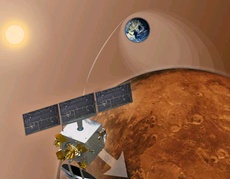ISRO successfully test-fires Mangalyaan’s liquid engine
22 Sep 2014
The Indian Space Research Organisation (ISRO) today said that the scientists have successfully test-fired the main liquid engine on India's Mars orbiter spacecraft.
 ''We had perfect burn for 4 seconds as programmed. The trajectory has been corrected,'' ISRO said.
''We had perfect burn for 4 seconds as programmed. The trajectory has been corrected,'' ISRO said.
With the successful firing of the liquid engine, which was crucial in determining the fate of Mars Orbiter mission, the Mars Orbiter Mission will now go ahead with the plan for Mars Orbit Insertion.
On 24 September ISRO will activate the spacecraft's eight thrusters to slow down Mangalyaan and inject it into a safe orbit around the Red Planet.
"Mars Orbiter engine test firing must have completed. We'll get a confirmation after the communication delay of 12 minutes." A few minutes later,'' ISRO it tweeted after igniting the engine.
The manoeuvre of firing the engine took place around 2.30pm today when the main liquid engine of the spacecraft was fired for 4 seconds. The craft's 440 Newton Liquid Apogee Motor engine, which had been idle for 300 days since the spacecraft left the Earth's orbit on a Martian trajectory on 1 December 2013, had a perfect burn for four seconds as planned, ISRO said.
The engine was test fired for 3.968 seconds with fuel consumption of about 0.567 kg and with a decremental velocity of 2.142 meters/second. The test was to make sure that the engine is in good shape for the 24-minute manoeuvre on Wednesday, it added.
The ISRO's MOM team loaded commands last week to test if the engine, specially designed for the final manoeuvre, is in working order.
ISRO had even prepared an alternative plan in case the 440Newton engine fails to fire as planned.
Plan B was to fire the eight thrusters originally meant for altitude control and orientation. Since these thrusters have less power (22Newton), they will have to be fired for a much longer duration; and the orbit achieved would not be ideal to carry out studies of the Mars atmosphere and morphology.
"The difference between success and failure is very thin," ISRO chairman K Radhakrishnan said earlier. "If the main engine fires, we will be able to get into a Martian orbit with a periapsis (closest point to Mars) of 423km and an apoapsis (farthest point) of 80,000km. Plan B will also help us get into an orbit, but at this point we don't know how close that would be."
The 440N liquid engine was last fired on 1 December to slingshot the spacecraft from an Earth orbit to the Martian trajectory. The spacecraft authorisation committee earlier this month decided to carry out the four-second test to ensure that the long idling hasn't affected the engine, which carries corrosive fuel.
Scientists are monitoring the Mars Orbiter Mission at the ISRO telemetry, tracking and command Network in Bangalore.
ISRO had also put in place parallel fuel and oxidiser circuits so that supply of fuel and other agents to the engine and the thrusters was not affected at any time.






























